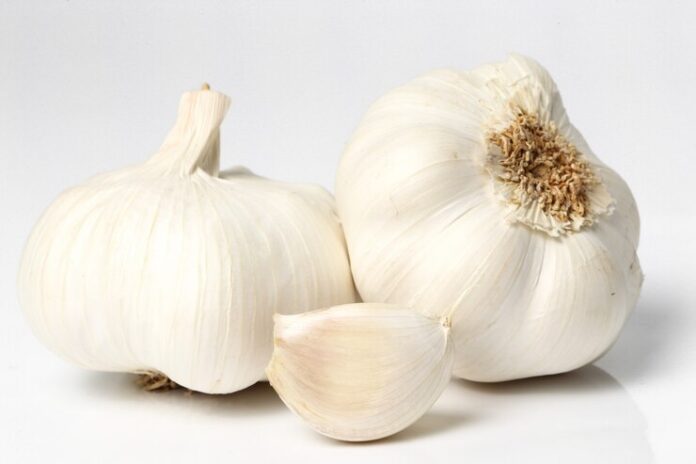Garlic is a widely cultivated plant known for its pungent aroma and distinctive flavor. It belongs to the onion family, along with shallots, leeks, and chives. The bulb of the garlic plant is composed of several individual cloves, each enclosed in a papery skin.
Culinary Uses:
- Garlic is a versatile ingredient in the culinary world, known for its robust flavor and aroma. Here are some common culinary uses of garlic:
- Seasoning: Garlic is frequently used as a seasoning to add depth and complexity to dishes. Whether minced, crushed, sliced, or roasted, garlic infuses a savory flavor into sauces, soups, stews, and marinades.
- Base Flavor: Many recipes start by sautéing chopped or minced garlic in oil or butter to create a flavorful base. This technique, known as “aromatizing,” helps release the essential oils and flavor compounds in garlic, enhancing the taste of the entire dish.
- Condiments and Spreads: Garlic can be used to make various condiments and spreads, such as garlic butter, garlic aioli, garlic paste, and garlic-infused oils. These flavorful additions are versatile and can be used as dips, spreads, or toppings for bread, crackers, and vegetables.
- Meat and Seafood: Garlic pairs well with meats, poultry, and seafood, adding depth and richness to dishes. It can be used to season roasts, grilled meats, sautéed vegetables, and stir-fries. Garlic shrimp, garlic chicken, and garlic steak are popular dishes that showcase its versatility.
- Pasta and Grains: Garlic is a staple ingredient in many pasta sauces, such as marinara, Alfredo, and aglio e olio (garlic and oil). It can also be added to risottos, pilafs, and grain-based dishes to enhance their flavor and aroma.
- Vegetarian and Vegan Dishes: Garlic is commonly used in vegetarian and vegan cooking to add depth of flavor to plant-based dishes. It can be incorporated into vegetable stir-fries, roasted vegetables, soups, salads, and grain bowls for added complexity.
- Bread and Baked Goods: Garlic can be used to flavor bread, rolls, and other baked goods. Garlic bread, garlic knots, and garlic-infused focaccia are popular examples of savory baked goods that feature garlic as a primary flavoring agent.
- Pickles and Fermented Foods: Garlic can be pickled or fermented to create tangy and flavorful condiments, such as pickled garlic cloves or garlic-infused vinegar. These preserved garlic products add a punch of flavor to salads, sandwiches, and charcuterie boards.
Veritas of garlic
There are numerous varieties of garlic cultivated around the world, each with its own unique characteristics in terms of flavor, bulb size, clove arrangement, and growth requirements. Here are some common varieties of garlic:
- Softneck Garlic:
- Artichoke Garlic: This variety typically has large, layered bulbs with a mild flavor. It’s commonly grown in mild climates and is known for its long storage life.
- Silverskin Garlic: Silverskin garlic bulbs have a soft, pliable stem and a strong flavor. They are often braided together and are well-suited for braiding and storage.
- Hardneck Garlic:
- Rocambole Garlic: Rocambole garlic is prized for its rich, complex flavor and easy-to-peel cloves. It typically has fewer but larger cloves per bulb and is well-suited for cooking and roasting.
- Porcelain Garlic: Porcelain garlic varieties are known for their large, uniform bulbs and robust flavor. They have fewer cloves per bulb and are often favored by chefs for their culinary versatility.
- Purple Stripe Garlic: This variety is characterized by its vibrant purple stripes on the bulb wrappers. It has a strong, spicy flavor and is often used in cooking and for making garlic-infused oils and vinegars.
- Marbled Purple Stripe Garlic: Similar to Purple Stripe garlic, Marbled Purple Stripe varieties have colorful bulb wrappers with marbled patterns. They are known for their complex flavor and are prized by garlic enthusiasts and chefs.
- Elephant Garlic: Despite its name, elephant garlic belongs to a different species (Allium ampeloprasum) and is actually more closely related to leeks than true garlic. It has large, mild-flavored bulbs and is often used as a garlic substitute in recipes.
- Creole Garlic: Creole garlic varieties are grown in warmer climates and are known for their spicy flavor and colorful bulb wrappers. They are often used in Cajun and Creole cuisine and are prized for their unique flavor profile.
Health Benefits:
- Garlic has been associated with various potential health benefits, thanks to its rich nutritional profile and bioactive compounds. Here are some of the notable health benefits associated with garlic:
- Cardiovascular Health: Garlic has been studied for its potential to promote heart health by lowering cholesterol levels and reducing blood pressure. Allicin, a sulfur-containing compound found in garlic, is believed to have vasodilatory effects, which may help relax blood vessels and improve circulation. Regular consumption of garlic may help reduce the risk of heart disease and stroke.
- Antioxidant Properties: Garlic contains antioxidants, including flavonoids and sulfur compounds, that help neutralize harmful free radicals in the body. These antioxidants may help reduce oxidative stress and inflammation, which are linked to chronic diseases such as cancer, diabetes, and neurodegenerative disorders.
- Immune Support: Garlic has long been valued for its immune-boosting properties. It contains compounds like allicin and sulfur, which have antimicrobial and antiviral properties that may help the body fight off infections. Consuming garlic regularly may help strengthen the immune system and reduce the risk of respiratory infections such as the common cold and flu.
- Anti-inflammatory Effects: Some studies suggest that garlic may have anti-inflammatory effects, which could benefit conditions characterized by chronic inflammation, such as arthritis, inflammatory bowel disease, and asthma. By reducing inflammation, garlic may help alleviate symptoms and improve overall health.
- Improved Digestive Health: Garlic has been used traditionally to promote digestive health and alleviate digestive issues such as bloating, gas, and indigestion. It may help stimulate digestion, enhance nutrient absorption, and support the growth of beneficial gut bacteria.
- Antimicrobial Properties: Garlic exhibits antimicrobial activity against a wide range of bacteria, viruses, fungi, and parasites. It has been used historically as a natural remedy for various infections, wounds, and skin conditions. Some research suggests that garlic may help inhibit the growth of harmful pathogens and promote wound healing.
- Cancer Prevention: Although more research is needed, some studies have suggested that garlic may have potential anticancer effects. Garlic contains sulfur compounds that may help inhibit the growth and spread of cancer cells, particularly in the digestive system (such as stomach and colon cancer) and other organs.
Cultvate garlic
Garlic cultivation involves several steps to ensure optimal growth and yield. Here’s an overview of the process:
- Selecting Garlic Varieties: There are different varieties of garlic, each with its own flavor profile, bulb size, and growing requirements. Farmers typically choose varieties based on their local climate, soil conditions, and market demand.
- Preparing the Soil: Garlic thrives in well-drained, fertile soil with good organic matter content. Before planting, the soil is prepared by tilling or plowing to loosen it and remove any weeds. Adding compost or organic matter can improve soil structure and fertility.
- Planting Garlic Cloves: Garlic is typically propagated by planting individual cloves rather than seeds. Each bulb is made up of several cloves enclosed in a papery skin. Farmers break apart the bulb into individual cloves and plant them pointy end up, about 2-4 inches deep and spaced 4-6 inches apart in rows. The planting depth and spacing may vary depending on the variety and local growing conditions.
- Providing Adequate Water and Nutrients: Garlic requires consistent moisture throughout the growing season, especially during bulb formation. Irrigation methods such as drip irrigation or soaker hoses are often used to deliver water directly to the roots while minimizing water waste. Additionally, applying organic or balanced fertilizer can provide essential nutrients to support healthy growth.
- Managing Weeds and Pests: Weeds compete with garlic for nutrients, water, and sunlight, so weed control is essential. Farmers may use mulch, cultivation, or herbicides to suppress weeds and maintain a clean growing environment. Additionally, garlic is susceptible to pests such as aphids, thrips, and nematodes, which can damage plants and reduce yields. Integrated pest management (IPM) strategies may include crop rotation, beneficial insects, and careful monitoring to minimize pest damage.
- Harvesting Garlic: Garlic is typically ready for harvest when the lower leaves turn yellow or brown and begin to dry out, usually 6-9 months after planting. Farmers use various methods to determine harvest readiness, such as gently pulling up a few plants to check bulb size and maturity. Once harvested, garlic bulbs are cured by drying them in a well-ventilated, dry area for several weeks to improve flavor, storage quality, and shelf life.
- Storing and Marketing Garlic: Cured garlic bulbs are stored in a cool, dry place with good air circulation to prevent mold and sprouting. Depending on market demand, garlic may be sold fresh, braided, or processed into value-added products like garlic powder, garlic oil, or garlic paste.
Other Uses:
- Folk Remedies: Garlic has a long history of use in traditional medicine for various purposes, including treating coughs, digestive issues, and skin conditions.
- Pest Repellent: Garlic is sometimes used as a natural insect repellent in gardens to deter pests from damaging plants.


